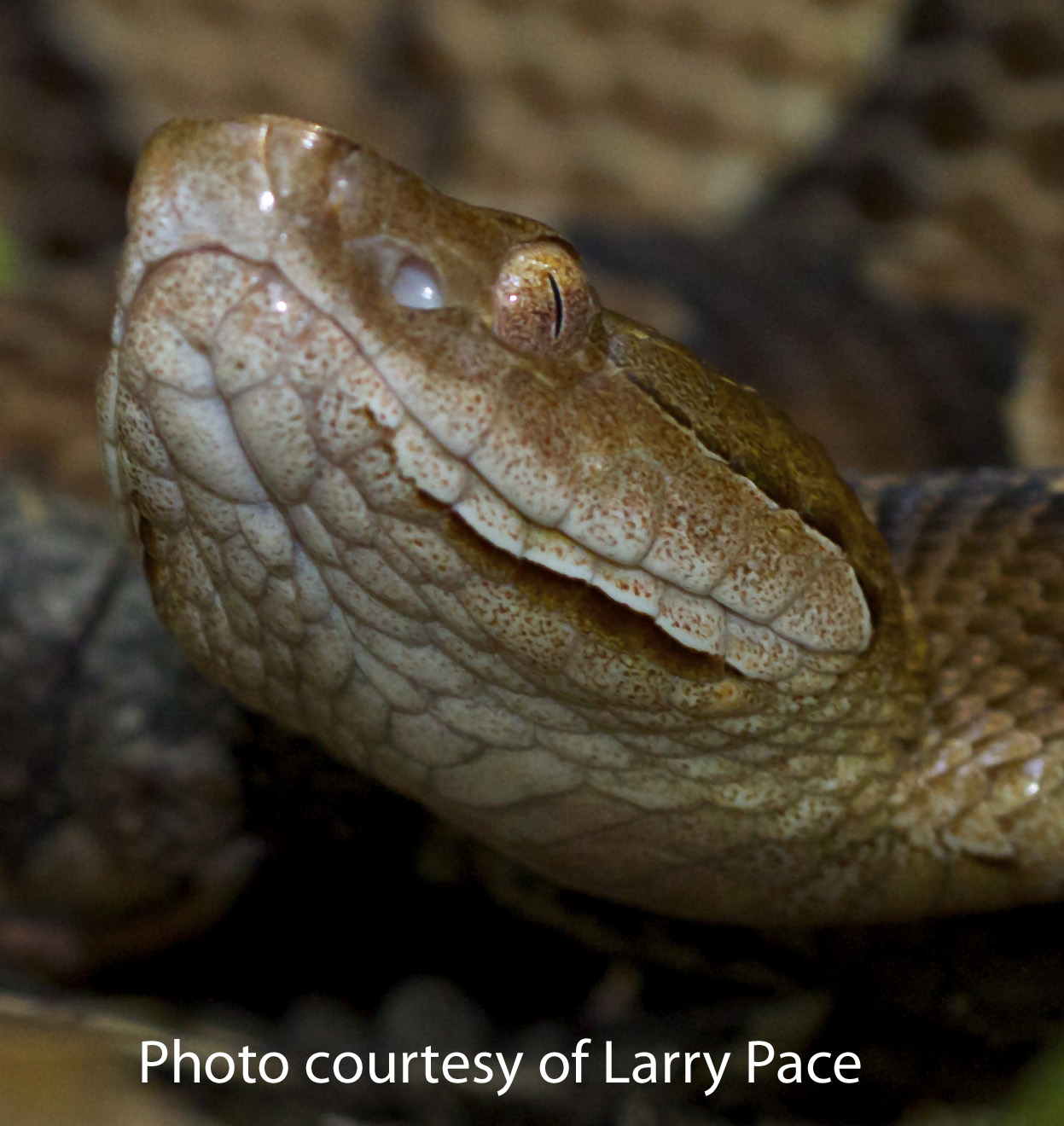Venomous Snakes
The characteristics of the venomous snakes and actions to take in
case of bites discussed below should be memorized before heading to the
field in search of snakes.
There are six species of
venomous snakes in the state of
Mississippi. Five of the six are in the family Viperidae (Pit
Vipers). All of these snakes have two readily identifiable
characteristics – actually three but do not attempt identification by
anal plates unless ABSOLUTELY sure the snake is immobilized where it
can’t bite. First their eyes have elliptical pupils (looks like a
cat’s eye, see photo below center), the non-venomous species in the
state have round pupils (see photo on left below). Second the vipers
have a heat sensing pit between each nostril and
eye (see photo below center). The heat sensing pit is used to
detect prey and
help deliver the strike, making them very accurate. The five pit
vipers found in Mississippi are – the Cottonmouth (Agkistrodon piscivorous), Copperhead (Agkistrodon contortrix), Pigmy Rattlesnake (Sistrus miliarus), Timber Rattlesnake (Crotalus horridus), and Eastern Diamondback Rattlesnake (Crotalus adamanteus).
The rattlesnakes get their name from the dry scales found at the tip of the tail
which are rapidly vibrated against one another, producing a buzzing
sound when the snake is excited. When born, the young snakes have
a button and add a new segment each time the snake sheds it's
skin. It is a myth that you can tell how old a rattlesnake is by
the number of rattles present. A well fed individual may shed
several times over the course of a year and as they grow, some (rarely
all) rattles are broken off. The Pit Vipers have two types of toxins; hemolysins and
hematoxins. Both of these act on the blood causing respiratory
failure. All vipers deliver venom through the two fangs
located at the top of the mouth.
The other venomous snake in Mississippi is the Eastern Coral
Snake (Family: Elapidae – Cobras). This is a secretive snake that
is usually never encountered. It has alternating rings of black,
yellow, red, yellow with a black snout and round pupils. A
harmless mimic (look alike) of the coral snake is the Scarlet Kingsnake
that has alternating bands of black, red, black, yellow; and a red
snout. It is essential that you know the difference between the
two before attempting to capture one. The following rhyme might
help to tell the difference – “Red on black is a friend of Jack, red on
yellow will kill a fellow.” The coral snake’s venom is a
neurotoxin which disrupts the nerve synapses resulting in heart failure.
The links below describe each of Mississippi’s venomous snakes with photos that are useful for identification.
Cottonmouth – Agkistrodon piscivorous
Copperhead – Agkistrodon contortrix
Pigmy Rattlesnake – Sistrurus miliarius
Timber Rattlesnake – Crotalus horridus
Eastern Diamondback Rattlesnake – Crotalus adamanteus
Eastern Coral Snake – Micrurus fulvius
What to do in case of snake bite:
First, it is important to know that the vast majority of snake bites
are from non-venomous species. These bites will appear as a
scratch or pair of scratches similar to what blackberry scratches look
like (they feel about the same as well). With the exception of
the coral snake, venomous snake bites will be a pair of puncture wounds
(sometimes only one fang will penetrate in which case there will be a
single puncture) and will be painful (much more so than a blackberry
scratch). If it is determined that the bite is from a venomous
snake, it is more than likely a dry bite (no venom was injected – but
still painful). However, bites from venomous snakes must be taken seriously and prompt medical attention is needed. Consult the Center for Disease Control at this link http://www.cdc.gov/niosh/topics/snakes/ for the most up to date procedures for venomous snake bites.

